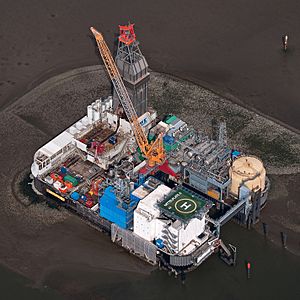Oil platform facts for kids
An oil platform is a huge structure built in the sea. Its main job is to drill deep into the seabed to find and bring up oil or natural gas. Some platforms stay in one spot, fixed to the ocean floor, while others can move around.
Most oil platforms are found on the continental shelf. This is the part of the seabed that slopes gently away from a continent. By 2006, it was possible to drill for oil and gas up to 8 kilometers (about 5 miles) away from the platform itself!
Contents
What is an Oil Platform?
Oil platforms are like giant floating (or fixed) factories in the ocean. They are designed to handle tough conditions, like strong winds and big waves. These platforms are essential for getting energy resources from under the sea.
Why Do We Need Them?
Many of the world's oil and natural gas reserves are located deep beneath the ocean floor. Oil platforms make it possible to reach these valuable resources. The oil and gas collected are then sent to shore through pipelines or by special ships.
Types of Oil Platforms
There are different kinds of oil platforms, each designed for specific depths and conditions:
- Fixed Platforms: These are built on strong legs that are anchored directly to the seabed. They are used in shallower waters and are very stable.
- Floating Platforms: These platforms float on the water and are held in place by strong anchors or special positioning systems. They are used in deeper waters where fixed platforms are not practical. Examples include:
- Semi-submersible Platforms: These platforms have large, submerged pontoons that make them stable in rough seas.
- Spar Platforms: These are tall, slender floating structures that are anchored to the seabed.
- Tension-Leg Platforms (TLPs): These platforms are held in place by vertical cables that are pulled tight, giving them great stability.
- Jackup Rigs: These are mobile platforms with long legs that can be lowered to the seabed. Once the legs are on the bottom, the platform body is "jacked up" above the water. They are used for drilling in shallower areas and can be moved to different locations.
How Do Oil Platforms Work?
Oil platforms use special drilling equipment to create wells that go thousands of meters into the earth beneath the ocean. Once a well is drilled, the oil or gas flows up through pipes to the platform.
From Platform to Shore
After the oil or gas is brought to the surface, it needs to be processed and transported.
- Pipelines: Often, long underwater pipelines carry the oil and gas from the platform directly to processing plants on land.
- Tankers: For platforms that are very far from shore or don't have pipelines, large ships called oil tankers are used to transport the crude oil.
Safety and the Environment
Working on an oil platform can be dangerous, so safety is a top priority. Workers live and work on these platforms for weeks at a time. There are strict rules and procedures to prevent accidents.
Protecting the ocean environment is also very important. Companies try to prevent oil spills and reduce any impact on marine life. New technologies are always being developed to make drilling safer and more environmentally friendly.
Images for kids
-
Oil platform P-51 off the Brazilian coast is a semi-submersible platform.
-
Oil wells just offshore at Summerland, California, before 1906.
-
Offshore platform, Gulf of Mexico
-
A fixed platform base under construction on the Atchafalaya River.
-
A 400-foot tall jackup rig being towed by tugboats in Kachemak Bay, Alaska.
-
Troll A natural gas platform, a gravity-based structure, under construction in Norway. Almost all of the 600,000-ton structure will end up submerged.
See also
 In Spanish: Plataforma petrolífera para niños
In Spanish: Plataforma petrolífera para niños












